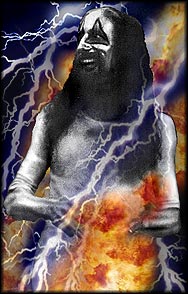...a figure
just perfect for Calvert's satirical rock-sketch comedy on the Starfighter
affair.
- and so was Arthur
Brown's unique voice & style for the role of the Gremlin...
Calvert:
"Arthur Brown is definitely
the bloke to play the Gremlin - that's the mythological thing that pilots
talk about half jokingly as causing faults."
During this almost
'tribal gathering' of the psychedelic music scene at the time of the recordings,
Arthur was one of many reknown Calvert collaborators.
Read his highly amusing anecdotes
on Calvert - when he was introducing him to Vivian
Stanshall of the Bonzo
Dog Doo Dah Band - another collaborator on Captain
Lockheed...
As Robert
Calvert and Hawkwind
became extremly influential artists for countless musicians and bands
to come so was / is Arthur Brown - though his
influence is even more obvious - and more of the influenced artists are
quite outspoken about it.
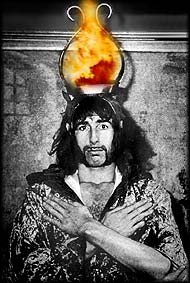 Says Parliament / Funkadelic mastermind
Says Parliament / Funkadelic mastermind
George Clinton:
> Brown's 'Fire'
was directly responsible for P-Funk's own stage circus.
He'd
set fire to his fuckin' head!
That told me a lot.
I knew where I was heading from then on. <
SEE
Arthur in his
full blown fiery glory.
Arthur Brown
came from Whitby on the Yorkshire coast, son of a pub piano player. His
first musical experience was singing duets with his brother in church.
Later on he learned to play banjo, guitar, and double bass and practiced
classical voice exercises for six months.
The results should be heard later on in the unfamiliar terrain of rock-music.
There was hardly any other vocalist with the mastery over a tonal range
comparable to Brown's.
During / after some
time at the university he started out as a singer for various blues-oriented
bands, often touring the continent, gigging a lot and quite successfully
in for a while in Paris.
"People like Salvador
Dali and Ornette
Coleman often went along to observe the scenes at the club, which
eventually developed into a case of the upper class people going along
to watch members of the middle class as they in turn watched the beatniks
and freaks having fits and convulsions.
It was here that Arthur began developing a stage act to match and improve
on the wild atmosphere of the club, including wearing make-up and crown
with lit candles."
(from an article by
Lee Broughton - see link at the bottom)
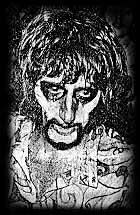 Well, these were the earliest signs of the impressive and forceful show
Arthur was going to develop about a year later or so, when he finally
got The
Crazy World of Arthur Brown together - accompanied by Vincent
Crane and Carl Palmer - who were later on co- founders of Atomic
Rooster and Emerson, Lake & Palmer
Well, these were the earliest signs of the impressive and forceful show
Arthur was going to develop about a year later or so, when he finally
got The
Crazy World of Arthur Brown together - accompanied by Vincent
Crane and Carl Palmer - who were later on co- founders of Atomic
Rooster and Emerson, Lake & Palmer
The band played various
clubs - but their rise to fame really began when they got invited to play
the famous UFO club, where Syd
Barrett's Pink Floyd were beginning their
own rise to stardom at the very same time.
Both bands appeared at the legendary 24 Hour Technicolor Dream event -
held at the Alexandria Palace in April 1967.
The band was discovered
by The Who's leading man Pete
Townsend who convinced Track Records to sign them.
Though the first single release failed to chart the band became increasingly
popular on the live circuit. The finally entered the studio again in late
'67 to record their classic Crazy World of Arthur Brown
album, including the soon to become legendary song Fire.
writes Lee Broughton:
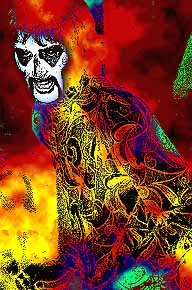 "The album was co-produced
by Pete Townsend who included strings and horns in an attempt to add dramatic
effect usually provided by the light show and theatrics. The songs on
side 1 form a short story about a spiraling journey into the Underworld.
The music is very energetic and full of urgency and it must rate as one
of the most exciting album sides ever recorded with vocals, bass, organ,
drums and horns reaching a fever pitch at times. These songs were in fact
just a small selection of songs taken from a full length opera that Arthur
and Vincent had written called Tales from the Neurotic
Nights of Hieronymous Anonymous in which the world spoke to Hieronymous
and different gods visited him. Even though the songs fit into the concept,
each song is more than strong enough to stand by itself as Fire
later proved."
"The album was co-produced
by Pete Townsend who included strings and horns in an attempt to add dramatic
effect usually provided by the light show and theatrics. The songs on
side 1 form a short story about a spiraling journey into the Underworld.
The music is very energetic and full of urgency and it must rate as one
of the most exciting album sides ever recorded with vocals, bass, organ,
drums and horns reaching a fever pitch at times. These songs were in fact
just a small selection of songs taken from a full length opera that Arthur
and Vincent had written called Tales from the Neurotic
Nights of Hieronymous Anonymous in which the world spoke to Hieronymous
and different gods visited him. Even though the songs fit into the concept,
each song is more than strong enough to stand by itself as Fire
later proved."
Fire
stayed in the charts
for 14 weeks, becoming number one after 3 weeks - and the album remained
in the top ten for 8 weeks.
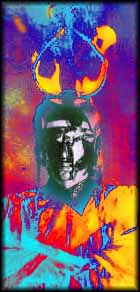 At this time Arthur had developed his outstanding stage-act - with the
quite dangerous climax of setting fire to a huge helmet he wore. Several
times he got burned....
At this time Arthur had developed his outstanding stage-act - with the
quite dangerous climax of setting fire to a huge helmet he wore. Several
times he got burned....
The wild and passionate
energy of the first album is hard to describe - hearing is believing.
Vincent
Crane is as much a virtuoso on his keyboards as is Brown
with his voice. You'll hardly find another band that featured just drums,
a guitar and keyboards delievering such an intensive, manic performance.
The interest and
enthusiasm of the audiences were enormous. The Crazy
World did a tour with The Who, Joe Cocker
and other bands - after a while they were alternately co-heading with
The Who!
Then up-coming acts like Genesis and David
Bowie were their support acts - and obviously had a good look at
Arthur's stage show. Peter
Gabriel is quite open about it as well. He once told Brown before
one of his gigs: "You
will see a lot of yourself in me tonight."
However, the huge
success turned out to become one of the biggest problems for the band.
Long and tiresome tours together with a silly release strategy of their
company put so much pressure on the band that it disbanded after their
second US tour in '69.
Especially the mental stress of Brown's intense
performances lead to 'uncomfortable" results:
"For a while, I didn't
necessarily believe I was the devil, but felt as if I was supposed to
lay things open for people to see. Thank goodness that side of myself
disappeared.
After a while you think: 'God, how could I believe this?'"
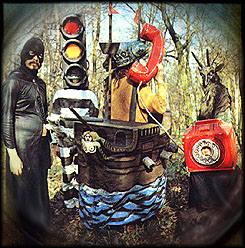 Back
in England, Arthur formed Kingdom Come, featuring
for a while the former Crazy World drummer Drachen
Theaker - a man, obviously on the same lunatic level as Keith Moon...but
that's another story...
Back
in England, Arthur formed Kingdom Come, featuring
for a while the former Crazy World drummer Drachen
Theaker - a man, obviously on the same lunatic level as Keith Moon...but
that's another story...
Kingdom Come released 3 or 4 albums with Journey
being the best and most successful of them.
The theatrical elements
remained an integral, important part of the show - they can be witnessed
also in the recent video-release of the Glastonbury
'72 festival film, which featured Kingdom Come as one of the top-acts.
"Kingdom Come
is a true multi-media experience - the band
dressed as clowns, pirates, monks, whores, the Pope and a four-headed
prisoner. Later the clown became a telephone, the Pope turned into a ship
and the monk changed into a traffic light..."
The stage act also
featured elements like 'Mr. Brain' - a small and lumpy grey matter severly
dented by the education system, a giant test tube, backdrops, a gauze
screen...
As SOUNDS
magazine put it:
"Arthur remains one of
the most perfect pieces of human mixed media
in existence. His voice, with it's huge range, is as powerful as ever
and his strange style of movements..."
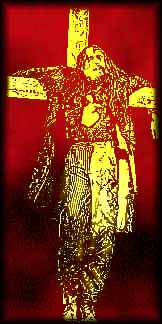 For a while
they even staged a crucifixion scene:
For a while
they even staged a crucifixion scene:
"The crucifixion scene
was originally meant to be a symbol of the persecution by the moguls of
the record business but in the end, if just became a good way to start
the act."
Kingdom
Come was also
one of the first bands to use a drum machine - in the studio AND on stage
- which was quite adventurous in those day, with these machines being
much more unreliable than today.
It is reported that at one gig at the Marquee club
'Ace Bentley' (the name of the machine) wouldn't stop to play it's
programmed rhythm for one song - it just went on ...and on....and on...
The band was pushing every button, throwing cans at it...everything they
had at hand...
But Ace kept the pace...for about 1 1/2 solid
hours.
The band had to go with it.
"We managed to pull
through, but it was one of the weirdest jams I've ever been in, and I've
been in some weird ones."
For
Kingdom Come the Machine-Age had already begun....
However, most of
the time Ace was a reliable fellow and Arthur,
who programmed the machine-member himself, was very satisfied with the
results:
"The ordinary drum-kit is limited by what the hand and feet of the drummer
can do, and also by the problem of amplifying it's sound. The
'Rhythm Ace', in that sense, is equivalent to 200 drum kits.
It frees the whole scope
of rhythm and lets you get into patterns of rhythm that you just can't
get with a drum kit.
On this one, for example, you can have a drum kit and a Latin-American
section at the same time - there's no way you could do that otherwise.
The Rhythm
Ace gives you any rhythm that a drummer can play as well as rhythmic
combinations that can't be played on anything but the machine.
But it is not so much a substitute for a drummer and a kit but a new direction
for the rhythmic basis of rock music. The sounds it produces are like
drum sounds, but they're not the same as drum sounds. They're percussion
sounds.
I
think that's what lies ahead in the future - we'll see people getting
into percussion rather than drumming. There's definitely a new era of
music coming."
...well, just think
of the rhythm patterns of all the techno-tribal music. The man was absolutely
right - and quite ahead of his time.
But of course, also
Kingdom
Come wasn't meant to last an eternal lunchtime and disbanded around
1974.
Arthur then travelled
a lot - to Israel where he became (for the first time) a kind of musical
therapist, playing to severly wounded Israelian soldiers in a hospital.
Then he went to Turkey to settle for a while with one of the last tribes
practising dervish dancing - a lot of other activities followed.
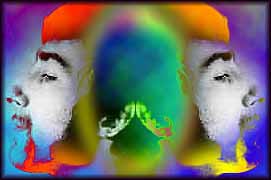 During the 70's he also collaborated with a lot of other musicians: He
did some impressive vocals on Alan
Parson's debut album Tales of Mystery and Imagination
and two albums, Dune and Time
Actor, with German synth-wizard Klaus
Schulze, respectively 'Richard Wahnfried', Schulze's pseudonym
on a side project.
During the 70's he also collaborated with a lot of other musicians: He
did some impressive vocals on Alan
Parson's debut album Tales of Mystery and Imagination
and two albums, Dune and Time
Actor, with German synth-wizard Klaus
Schulze, respectively 'Richard Wahnfried', Schulze's pseudonym
on a side project.
He also acted the part of the furious priest in Ken
Russel's / The Who's film
Tommy - and did another album with his former Crazy World keyboarder
Vincent
Crane: Faster than the Speed of Light.
In 1978 Arthur moved
to America and later settled in Austin, Texas. This is what he did since
then, in his own brief words:
"Being with my family.
I've been doing some music. I've done four albums now. I was also a house
painter. I had a company with Jimmy Carl Black
from The Mothers of Invention - we had a painting
company called the The Gentlemen of Colour. We used this name because
his name is Black and mine is Brown.
I also had council training, so I'm now a councillor working with drug
and alcohol rehabilitation. And in that I use music, instead of talking
I just had the guitar and made up stuff as I go along, and then I tape
it and take it away. We've been going over to a friend's big studio and
we'd record and play around."
This might all sound
like quite a chequered mix of casual activities - but you couldn't be
more wrong.
"I have spent years finding
stability in my life and family, and now I'm back to being the irresponsible
artist. I have a lot more experience now to put in the music. I'm 53,
but it gives me a certain pedigree.
I
can't dance like I could at 23, but I know more about it."
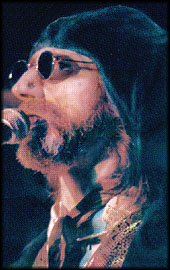 The last years saw
Arthur Brown on the road again, doing extensive
tours and releasing a new live album, recorded at the Marquee in 1993:
Order From Chaos, feat. a good mix of his CRAZY
WORLD classics with new material. His voice is obviously still
in fantastic shape - so is his performance style:
The last years saw
Arthur Brown on the road again, doing extensive
tours and releasing a new live album, recorded at the Marquee in 1993:
Order From Chaos, feat. a good mix of his CRAZY
WORLD classics with new material. His voice is obviously still
in fantastic shape - so is his performance style:
"I remember on the tour
last year suddenly finding myself in mid-air, upside-down with my hand
just about to hit the stage and saying to myself, 'How the fuck did I
get here?' It was lovely, music just takes you away and your body responds.
My wish to make contact with people through music was reaffirmed. This
form brought me face to face with my love of performing. It was like breathing
again after being in a dusty room"
So, the FIRE
is still burning - just a bit wiser and more experienced. Watch out for
it, is my advice - like a lot of other artists still do. Just recently
Arthur's songs have been covered by
Pete Townshend, techno-star Prodigy and
German crossover-meisters
Die Krupps - who also asked him to perform the vocals on their
version of Fire.
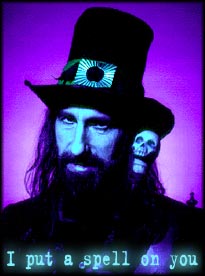
Keep it burning, Arthur.
In the upper text I
used excerpts of two comprehensive articles / interviews by Andy Langer
and Lee Broughton - you'll find the complete versions linked below. The
last interview snippets are taken from the "Psychedelic Guide to the Crazy
World of Arthur Brown" by Trevor Hughes and Dave Roberts - to be obtained
via:
Hawkfrendz, Zephyr, P.O. Box 6, Liscard, Wallasey, Merseyside L45 4SJ
THANK YOU!
The newest of NEWS on ARTHUR BROWN - it's the
| ARTHUR
BROWN UPDATE |
|
| |
-
by LEE BROUGHTON (c) 1998 |
After the success
of The
Even Crazier World Of Arthur Brown's
1993 summer
tour, the band hit the road and did it all over again in the summer of
1994.
Although these two tours did not feature Brown's trademark make-up and
theatrics, they did prove that he was still a master showman, revealing
a still commanding stage presence and voice and some incredible dance
and mime moves.
Brown's love of improvisation and doggerel rhyme were also very much in
evidence, along with some powerful new tunes. Unfortunately, the projected
new studio album failed to surface but the band did record a fine version
of 'The Green Manalishi' for the Peter Green tribute album 'Rattlesnake
Guitar'.
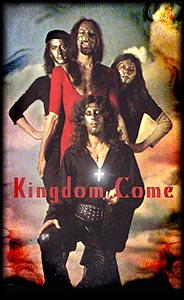 Renewed interest in Brown also resulted in the release of 'Jam', the original
Kingdom
Come audition tape. Brown returned to live performance in late
1995, when he went on the road with an act that consisted of himself,
guitarist Randall Ward and various backing tapes.
Renewed interest in Brown also resulted in the release of 'Jam', the original
Kingdom
Come audition tape. Brown returned to live performance in late
1995, when he went on the road with an act that consisted of himself,
guitarist Randall Ward and various backing tapes.
Though less dynamic than the previous two outings, this informal act did
provide more scope for messing about and interacting with the audience.
In St. Petersburg, Arthur played one song to a crowd of 100,000 people
when he turned up at the White Nights festival.
At some point in
1996, Brown signed a new management deal and a new
Crazy World Of Arthur Brown was assembled. A homecoming performance
in Whitby, as part of the town's Dracula Festival ('The Dracfest') in
September 1997, revealed a return to the familiar make-up and theatre-rock
shenanigans of yore, with the band reportedly being one of the highlights
of the festival.
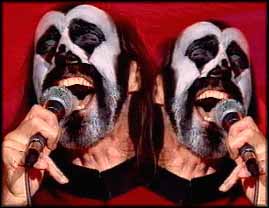 The band also reportedly made a big impression at The Recurring Technicolour
Dream show that was held at the Institute Of Contemporary Arts in London.
The band are said to have spent over two years in the studio, 'developing
a vampire fixation' and preparing demos for an 'unidentified project'
although Brown has escaped on at least two occasions to record a guest
spot on the 1997 album 'Paradise Now' by Die
Krupps and to contribute to Judge Smith's
epic work in progress Curly's
Airships.
The band also reportedly made a big impression at The Recurring Technicolour
Dream show that was held at the Institute Of Contemporary Arts in London.
The band are said to have spent over two years in the studio, 'developing
a vampire fixation' and preparing demos for an 'unidentified project'
although Brown has escaped on at least two occasions to record a guest
spot on the 1997 album 'Paradise Now' by Die
Krupps and to contribute to Judge Smith's
epic work in progress Curly's
Airships.
Sadly, the much anticipated
issue of an unreleased Vincent
Crane (Atomic
Rooster) project from the 70's, Taro
Rota, which featured some vocals by Brown, has gone ahead with
Brown's contributions missing due to 'contractual problems'.
Lee
Broughton, May
'98
Nov
'03 - the latest Update...
And there are quite a lot of News to tell - as it seems that Arthur Brown
is more active than ever!
As far as I know, a few years ago he returned to to live in the UK - at
first he appeared at several festivals and shortly after he released a
few new recordings - new material as "Tantric
Lover" and also stuff from the archives, like another collaboration
he did with Vincent Crane, the late mastermind
of Atomic Rooster - entitled Taro-Rota.
He gigged with various backing bands - plugged and unplugged and also
appears again with the reformed legendary Crazy World
of Arthur Brown. And from all the reports I read so far, it seems
he hasn't lost an ounce of his energy and his voice seems to be as impressive
as ever.
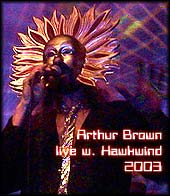 However,
the most interesting news in terms of the work of Robert Calvert is, that
Arthur has become kind of a member - or at least a permanent guest-performer
with HAWKWIND. He's
singing a couple of their tracks like the "evergreen" Silver
Machine and also a couple of his own tracks. An established part of the
current set-list of Hawkwind are also such Calvert classics as The
Song of the Gremlin, Ejection, The
Right Stuff - and, with the introduction of Arthur Brown, one of the
very best Calvert & Brock compositions re-appeared on-stage: STEPPENWOLF. However,
the most interesting news in terms of the work of Robert Calvert is, that
Arthur has become kind of a member - or at least a permanent guest-performer
with HAWKWIND. He's
singing a couple of their tracks like the "evergreen" Silver
Machine and also a couple of his own tracks. An established part of the
current set-list of Hawkwind are also such Calvert classics as The
Song of the Gremlin, Ejection, The
Right Stuff - and, with the introduction of Arthur Brown, one of the
very best Calvert & Brock compositions re-appeared on-stage: STEPPENWOLF.
It seems that with Arthur's presence a lot of the Calvert-ian elements
have returned to the live-set of Hawkwind, as he's re-introducing some
theatrical elements into the show, wearing masks, costumes... - and songs
like STEPPENWOLF
certainly call for that.
One or two Hawkwind live-albums came out recently - unfortunately I haven't
heard them - but they got rave-reviews all around - especially regarding
those tracks feat. Arthur Brown.
So, indeed, he keeps that FIRE burning....

LINKS
- More on Arthur Brown:

|

